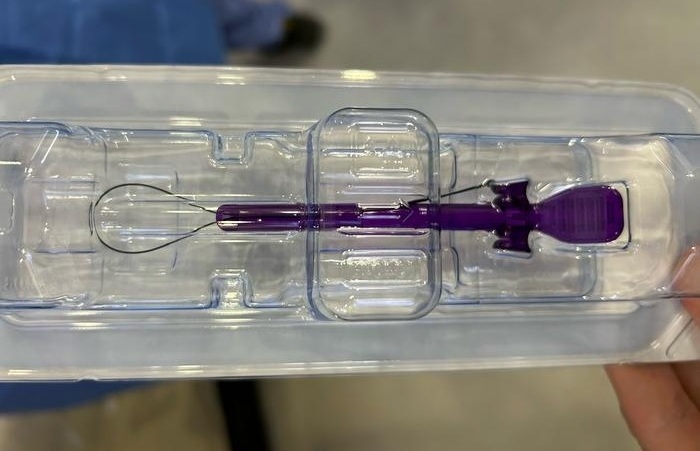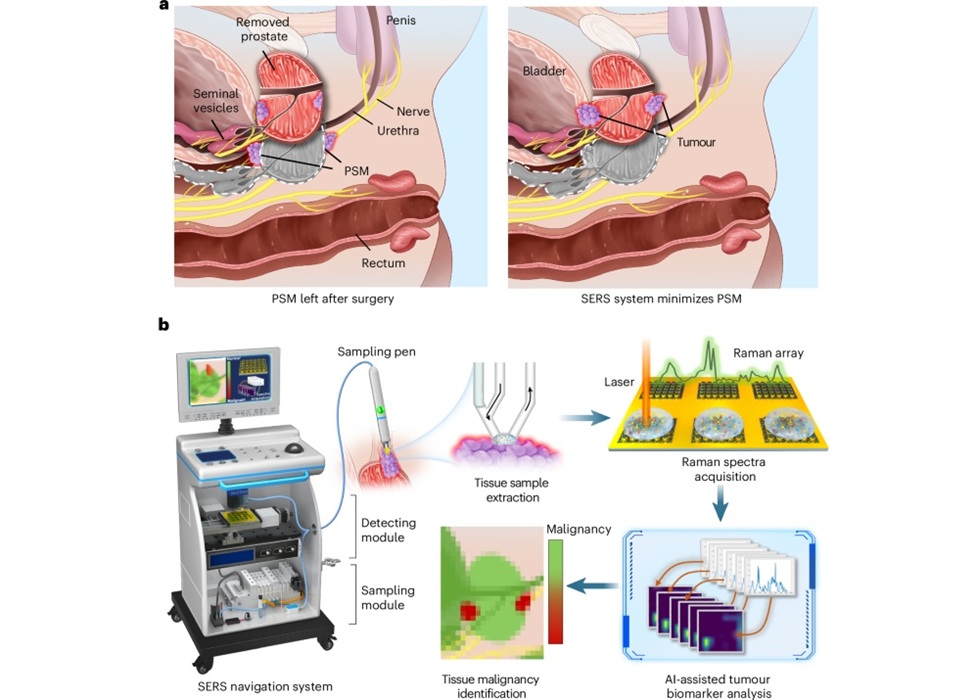Remote System Helps Rehabilitate Heart Pathologies 
|
By HospiMedica International staff writers Posted on 13 Jan 2015 |
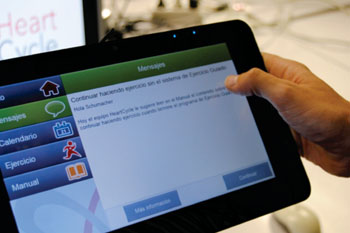
Image: The HeartCycle GEx mobile tablet device (Photo courtesy of Universitat Politècnica de València).
A new distance rehabilitation system for people affected by heart pathologies uses guided exercise (GEX) routines to help them adopt a healthy lifestyle.
Developed by researchers at Universitat Politècnica de València (UPV; Spain), Universidad Politécnica de Madrid (UPM; Spain), and Medtronic (Minneapolis, MN, USA), the HeartCycle GEx is based on a dedicated shirt with incorporated wireless sensors to monitor electrocardiogram (ECG), heart rate (HR), breathing frequency (BF), and activity during exercise. The information is streamed live to a mobile tablet device that creates an online connection between the cardiologist in the hospital and the patients in their homes.
The tablet device also provides streaming multimedia content, an avatar, and graphic information about the indicators related to the patient’s performance (such as heart rate, effort level, etc.). In addition, the HeartCycle GEx is connected to the hospital information system (HIS) in order to guarantee optimum, personalized health care for the patient. The system enables each user's condition to be monitored and the response to the instructed therapy assessed, so that individual plans can be created, and any deterioration in health status that requires immediate intervention can be detected.
The physician also has at his disposal a web application in which to program the prescribed plan adapted to the patient’s physical condition, as assessed by an effort test. The system was validated with 132 patients at three hospitals in Spain, Germany, and the United Kingdom and, according to the tests performed, it provides better results than traditional rehabilitation programs. The results of the study were published in the November 2014 issue of the European Journal of Preventive Cardiology.
“The Achilles' heel of heart rehabilitation is that patients abandon it in a few weeks, so its effect is watered down. If the user is motivated, the level of compliance will increase and their health will improve,” said Álvaro Martínez-Romero, a researcher at the ITACA Institute of the UPV. “The most important aspect is to improve adherence to the rehabilitation plan and maintain it over time, and this system does just that.”
“Today, the heart rehabilitation programs in Spain take place in hospitals or specialized centers. HeartCycle GEx is an initial step to the new heart rehabilitation systems of the future, providing personalized solutions, adapted to each patient and accessible from any location,” added Cecilia Vera Muñoz, MSc, a researcher at the Life Supporting Technologies Group of the UPM. “HeartCycle GEx is a different and convenient alternative to access to those programs since the patients can follow them anywhere, even at home, maintaining the level of health care that they receive.”
Related Links:
Universitat Politècnica de València
Universidad Politécnica de Madrid
Medtronic
Developed by researchers at Universitat Politècnica de València (UPV; Spain), Universidad Politécnica de Madrid (UPM; Spain), and Medtronic (Minneapolis, MN, USA), the HeartCycle GEx is based on a dedicated shirt with incorporated wireless sensors to monitor electrocardiogram (ECG), heart rate (HR), breathing frequency (BF), and activity during exercise. The information is streamed live to a mobile tablet device that creates an online connection between the cardiologist in the hospital and the patients in their homes.
The tablet device also provides streaming multimedia content, an avatar, and graphic information about the indicators related to the patient’s performance (such as heart rate, effort level, etc.). In addition, the HeartCycle GEx is connected to the hospital information system (HIS) in order to guarantee optimum, personalized health care for the patient. The system enables each user's condition to be monitored and the response to the instructed therapy assessed, so that individual plans can be created, and any deterioration in health status that requires immediate intervention can be detected.
The physician also has at his disposal a web application in which to program the prescribed plan adapted to the patient’s physical condition, as assessed by an effort test. The system was validated with 132 patients at three hospitals in Spain, Germany, and the United Kingdom and, according to the tests performed, it provides better results than traditional rehabilitation programs. The results of the study were published in the November 2014 issue of the European Journal of Preventive Cardiology.
“The Achilles' heel of heart rehabilitation is that patients abandon it in a few weeks, so its effect is watered down. If the user is motivated, the level of compliance will increase and their health will improve,” said Álvaro Martínez-Romero, a researcher at the ITACA Institute of the UPV. “The most important aspect is to improve adherence to the rehabilitation plan and maintain it over time, and this system does just that.”
“Today, the heart rehabilitation programs in Spain take place in hospitals or specialized centers. HeartCycle GEx is an initial step to the new heart rehabilitation systems of the future, providing personalized solutions, adapted to each patient and accessible from any location,” added Cecilia Vera Muñoz, MSc, a researcher at the Life Supporting Technologies Group of the UPM. “HeartCycle GEx is a different and convenient alternative to access to those programs since the patients can follow them anywhere, even at home, maintaining the level of health care that they receive.”
Related Links:
Universitat Politècnica de València
Universidad Politécnica de Madrid
Medtronic
Latest Critical Care News
- Biodegradable Patch Repairs Damaged Tissue After Heart Attack
- Magnetically Guided Microrobots to Enable Targeted Drug Delivery

- Smart Nanomaterials Detect and Treat Traumatic Brain Injuries Simultaneously
- Earlier Blood Transfusion Could Reduce Heart Failure and Arrhythmia in Heart Disease Patients
- 'Smart' Shirt Detects Epileptic Seizures in Real Time
- Skin Patch Measures Effectiveness of Flu/COVID Vaccines in 10 Minutes
- Complete Revascularization Reduces Risk of Death from Cardiovascular Causes
- Tiny Fish-Inspired Robots Navigate Through Body to Deliver Targeted Drug Therapy
- Coronary Artery Stenosis Could Protect Patients from Pulmonary Embolism Effects
- Sweat-Powered Sticker Turns Drinking Cup into Health Sensor
- Skin-Mounted 3D Microfluidic Device Analyzes Sweat for Real-Time Health Assessment
- New Therapeutic Brain Implants to Eliminate Need for Surgery
- Stem Cell Patch Gently Heals Damaged Hearts Without Open-Heart Surgery
- Biomaterial Vaccines to Make Implanted Orthopedic Devices Safer
- Deep Learning Model Predicts Sepsis Patients Likely to Benefit from Steroid Treatment
- Programmable Drug-Delivery Patch Promotes Healing and Regrowth After Heart Attack
Channels
Surgical Techniques
view channelNovel Endoscopy Technique Provides Access to Deep Lung Tumors
Detecting lung cancer early can save lives, but diagnosing small tumors deep in the outer regions of the lungs remains a major clinical challenge. Although CT scans frequently identify tiny suspicious... Read more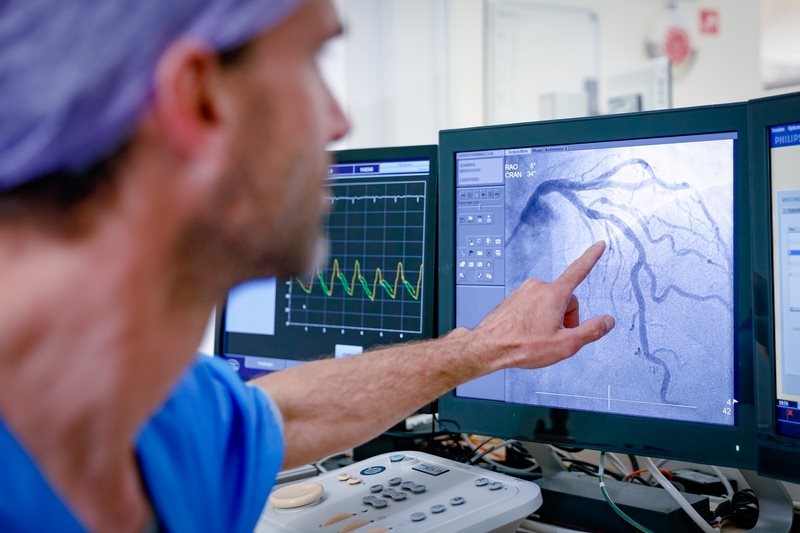
New Study Findings Could Halve Number of Stent Procedures
When a coronary artery becomes acutely blocked during a heart attack, opening it immediately is essential to prevent irreversible damage. However, many patients also have other narrowed vessels that appear... Read morePatient Care
view channel
Revolutionary Automatic IV-Line Flushing Device to Enhance Infusion Care
More than 80% of in-hospital patients receive intravenous (IV) therapy. Every dose of IV medicine delivered in a small volume (<250 mL) infusion bag should be followed by subsequent flushing to ensure... Read more
VR Training Tool Combats Contamination of Portable Medical Equipment
Healthcare-associated infections (HAIs) impact one in every 31 patients, cause nearly 100,000 deaths each year, and cost USD 28.4 billion in direct medical expenses. Notably, up to 75% of these infections... Read more
Portable Biosensor Platform to Reduce Hospital-Acquired Infections
Approximately 4 million patients in the European Union acquire healthcare-associated infections (HAIs) or nosocomial infections each year, with around 37,000 deaths directly resulting from these infections,... Read moreFirst-Of-Its-Kind Portable Germicidal Light Technology Disinfects High-Touch Clinical Surfaces in Seconds
Reducing healthcare-acquired infections (HAIs) remains a pressing issue within global healthcare systems. In the United States alone, 1.7 million patients contract HAIs annually, leading to approximately... Read moreHealth IT
view channel
EMR-Based Tool Predicts Graft Failure After Kidney Transplant
Kidney transplantation offers patients with end-stage kidney disease longer survival and better quality of life than dialysis, yet graft failure remains a major challenge. Although a successful transplant... Read more
Printable Molecule-Selective Nanoparticles Enable Mass Production of Wearable Biosensors
The future of medicine is likely to focus on the personalization of healthcare—understanding exactly what an individual requires and delivering the appropriate combination of nutrients, metabolites, and... Read moreBusiness
view channel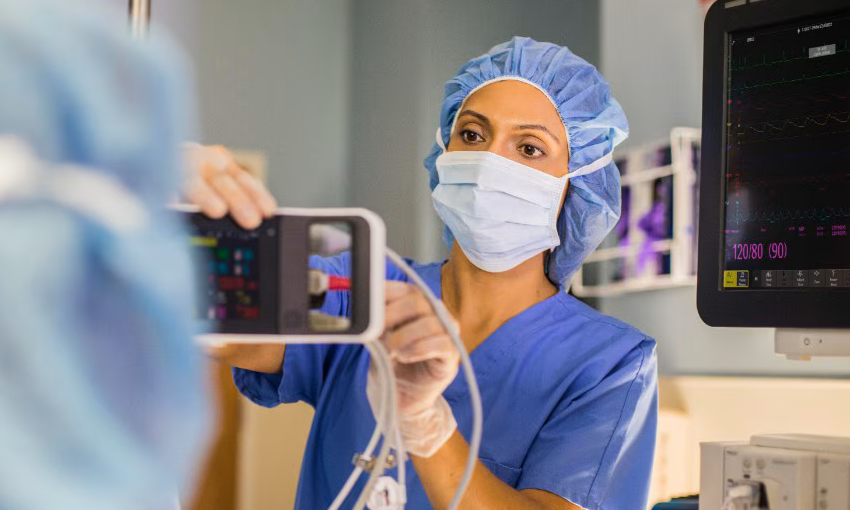
Philips and Masimo Partner to Advance Patient Monitoring Measurement Technologies
Royal Philips (Amsterdam, Netherlands) and Masimo (Irvine, California, USA) have renewed their multi-year strategic collaboration, combining Philips’ expertise in patient monitoring with Masimo’s noninvasive... Read more
B. Braun Acquires Digital Microsurgery Company True Digital Surgery
The high-end microsurgery market in neurosurgery, spine, and ENT is undergoing a significant transformation. Traditional analog microscopes are giving way to digital exoscopes, which provide improved visualization,... Read more
CMEF 2025 to Promote Holistic and High-Quality Development of Medical and Health Industry
The 92nd China International Medical Equipment Fair (CMEF 2025) Autumn Exhibition is scheduled to be held from September 26 to 29 at the China Import and Export Fair Complex (Canton Fair Complex) in Guangzhou.... Read more











